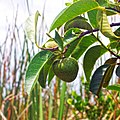Annona glabra
Annona glabra is a tropical fruit tree in the family Annonaceae, common in the Americas and Africa. It is best known for its fruit, the pond apple, which is a large, green fruit that is edible to both humans and animals.
Description[edit]
The Annona glabra tree can grow up to 12 meters tall. It has large, glossy leaves and large, fragrant flowers. The fruit is large, round, and green, with a sweet, custard-like pulp. The tree is often found in wet, swampy areas, hence its other common name, the swamp apple.
Distribution and habitat[edit]
Annona glabra is native to the tropical Americas, but it has been introduced to other tropical regions around the world. It is commonly found in Florida, the Caribbean, Central and South America, and West Africa. It prefers wet, swampy habitats, and is often found along riverbanks and in mangrove forests.
Uses[edit]
The fruit of the Annona glabra is edible and is often used in traditional medicine in various cultures. The pulp can be eaten raw or used to make jams and jellies. The seeds and leaves are also used in traditional medicine for a variety of ailments.
Conservation status[edit]
While not currently listed as threatened or endangered, the Annona glabra is considered a pest species in some areas where it has been introduced, due to its ability to outcompete native vegetation.
See also[edit]
-
Annona glabra fruit
-
Alligator eating pond apple
-
Annona glabra leaves
-
Annona glabra in Florida
-
Annona glabra
Ad. Transform your life with W8MD's Budget GLP-1 injections from $75


W8MD offers a medical weight loss program to lose weight in Philadelphia. Our physician-supervised medical weight loss provides:
- Weight loss injections in NYC (generic and brand names):
- Zepbound / Mounjaro, Wegovy / Ozempic, Saxenda
- Most insurances accepted or discounted self-pay rates. We will obtain insurance prior authorizations if needed.
- Generic GLP1 weight loss injections from $75 for the starting dose.
- Also offer prescription weight loss medications including Phentermine, Qsymia, Diethylpropion, Contrave etc.
NYC weight loss doctor appointmentsNYC weight loss doctor appointments
Start your NYC weight loss journey today at our NYC medical weight loss and Philadelphia medical weight loss clinics.
- Call 718-946-5500 to lose weight in NYC or for medical weight loss in Philadelphia 215-676-2334.
- Tags:NYC medical weight loss, Philadelphia lose weight Zepbound NYC, Budget GLP1 weight loss injections, Wegovy Philadelphia, Wegovy NYC, Philadelphia medical weight loss, Brookly weight loss and Wegovy NYC
|
WikiMD's Wellness Encyclopedia |
| Let Food Be Thy Medicine Medicine Thy Food - Hippocrates |
Medical Disclaimer: WikiMD is not a substitute for professional medical advice. The information on WikiMD is provided as an information resource only, may be incorrect, outdated or misleading, and is not to be used or relied on for any diagnostic or treatment purposes. Please consult your health care provider before making any healthcare decisions or for guidance about a specific medical condition. WikiMD expressly disclaims responsibility, and shall have no liability, for any damages, loss, injury, or liability whatsoever suffered as a result of your reliance on the information contained in this site. By visiting this site you agree to the foregoing terms and conditions, which may from time to time be changed or supplemented by WikiMD. If you do not agree to the foregoing terms and conditions, you should not enter or use this site. See full disclaimer.
Credits:Most images are courtesy of Wikimedia commons, and templates, categories Wikipedia, licensed under CC BY SA or similar.
Translate this page: - East Asian
中文,
日本,
한국어,
South Asian
हिन्दी,
தமிழ்,
తెలుగు,
Urdu,
ಕನ್ನಡ,
Southeast Asian
Indonesian,
Vietnamese,
Thai,
မြန်မာဘာသာ,
বাংলা
European
español,
Deutsch,
français,
Greek,
português do Brasil,
polski,
română,
русский,
Nederlands,
norsk,
svenska,
suomi,
Italian
Middle Eastern & African
عربى,
Turkish,
Persian,
Hebrew,
Afrikaans,
isiZulu,
Kiswahili,
Other
Bulgarian,
Hungarian,
Czech,
Swedish,
മലയാളം,
मराठी,
ਪੰਜਾਬੀ,
ગુજરાતી,
Portuguese,
Ukrainian





